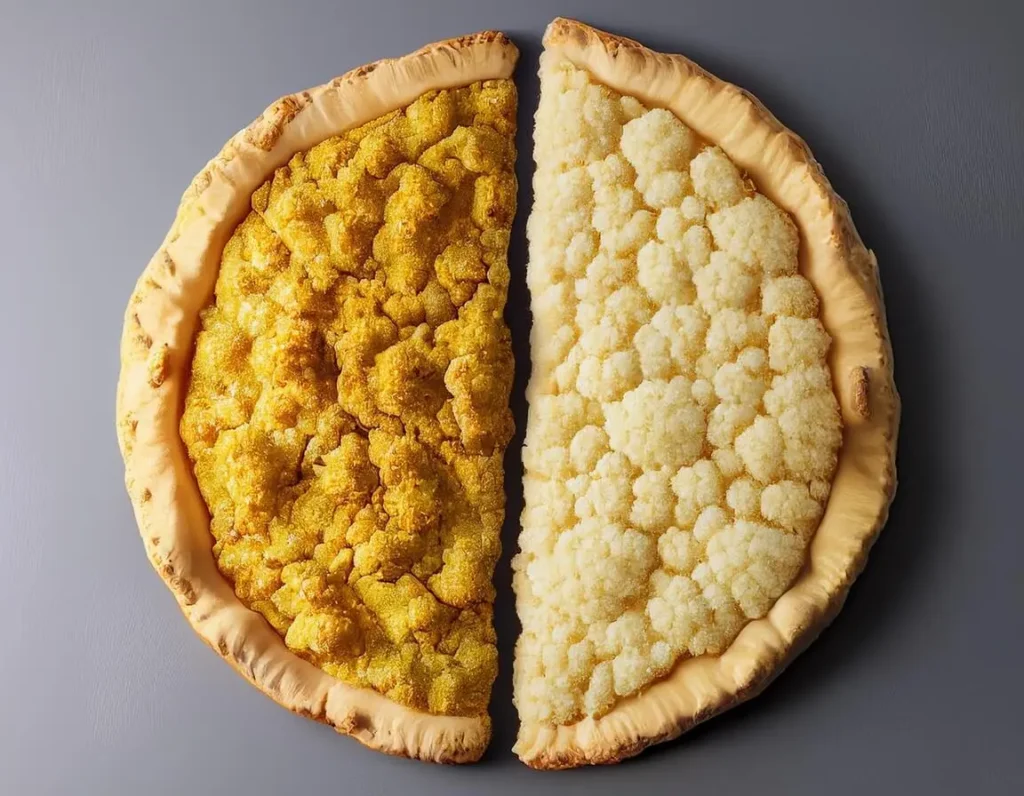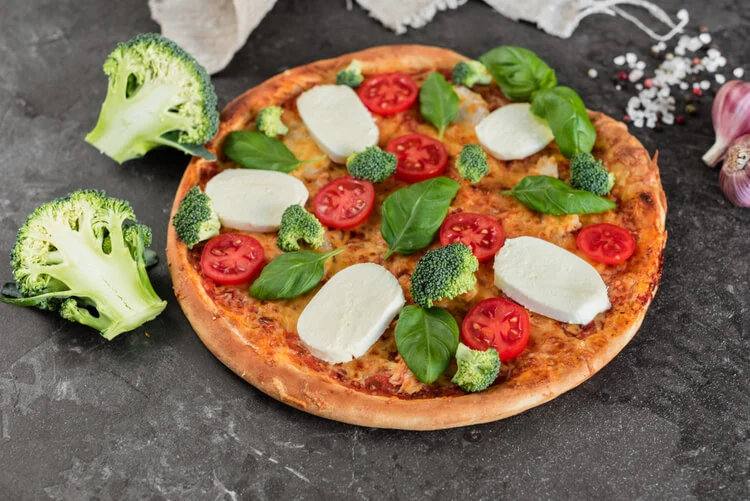Introduction
In recent years, cauliflower pizza crust has surged in popularity, particularly among health-conscious individuals and those seeking gluten-free alternatives. Its versatility and ability to accommodate various dietary needs have made it a go-to option for pizza lovers looking for something lighter and healthier. But a common question persists: how many calories are in a 10-inch cauliflower pizza crust?
The calorie content of a 10-inch cauliflower pizza crust can vary depending on the recipe or brand. On average, it contains significantly fewer calories than a traditional crust, making it an appealing option for those trying to cut down on calories without sacrificing the joy of pizza.

This article dives deep into the nutritional details of a 10-inch cauliflower pizza crust, comparing it to regular pizza crust in terms of calories, carbs, and overall benefits. We’ll explore how the ingredients impact the nutritional profile, provide a simple recipe for a homemade version, and answer frequently asked questions about this trending alternative. By the end, you’ll have all the information you need to decide whether cauliflower pizza crust is the right fit for your diet.
1. What Is Cauliflower Pizza Crust?
Cauliflower pizza crust is a modern twist on traditional pizza crust, offering a healthier and gluten-free alternative. Made primarily from cauliflower, this crust is a low-carb, nutrient-rich base that caters to a variety of dietary needs. Its popularity has soared in recent years, driven by growing demand for alternatives that support ketogenic, paleo, and gluten-free lifestyles.

The primary ingredients in cauliflower pizza crust include:
- Cauliflower: The star ingredient, providing a base that is low in carbs and high in fiber.
- Eggs: Used as a binding agent to hold the crust together.
- Cheese: Typically mozzarella or Parmesan, adding flavor and texture.
- Spices: Such as garlic powder, Italian seasoning, and salt to enhance the taste.
These simple ingredients combine to create a crust that is both flavorful and flexible, making it an excellent substitute for those avoiding traditional wheat-based crusts.
Cauliflower pizza crust is highly versatile and pairs well with a wide range of toppings. Whether you prefer classic margherita, veggie-loaded, or protein-packed options, this crust can handle it all. Its adaptability has contributed to its widespread appeal among people with different dietary preferences and goals.
For those looking to reduce calories or carbs without compromising on taste, cauliflower pizza crust provides a satisfying solution. Its ability to mimic the texture and structure of a regular crust while offering significant health benefits has cemented its place as a favorite among pizza enthusiasts.
For a deeper dive into its ingredients and preparation methods, check out this guide on what is cauliflower pizza crust made of.
To learn more about the nutritional advantages of using cauliflower as a base, explore these health benefits of cauliflower.
2. Calories in a 10-Inch Cauliflower Pizza Crust
The calorie content of a 10-inch cauliflower pizza crust can vary depending on the recipe or brand. On average, a homemade cauliflower pizza crust contains approximately 200–300 calories, while a store-bought version ranges between 250–400 calories. The difference often lies in the ingredients and preparation methods used.
Homemade Crust
When you make cauliflower crust at home, you have complete control over the ingredients. By keeping it simple—using cauliflower, eggs, cheese, and a few spices—you can minimize the calorie count. For example, skipping extra cheese or oil can keep the calorie range lower, closer to 200 calories.
Store-Bought Crust
Pre-packaged cauliflower crusts, while convenient, tend to include additional ingredients for flavor, texture, and shelf stability. These may include:
- Cheese and oils: Added for richness and binding.
- Flour substitutes: Such as almond or rice flour, which increase calorie content.
- Preservatives: Sometimes necessary for longer shelf life.
Depending on the brand, these additions can push the calorie count closer to the higher end of the spectrum.
Factors Influencing Calorie Content
Several factors impact the calorie count of a cauliflower pizza crust:
- Cheese content: More cheese increases both calories and fat.
- Oil usage: Adds calories without significantly altering the flavor.
- Topping choices: Although not part of the crust, toppings play a major role in total calorie intake.
While the calorie count of cauliflower pizza crust is generally lower than traditional crusts, the difference becomes more apparent in a direct comparison—something we’ll discuss in the next section.
3. Comparison: Cauliflower Pizza Crust vs. Regular Pizza Crust
For pizza enthusiasts striving to make healthier choices, understanding the differences between cauliflower pizza crust and traditional crust is crucial. Let’s examine how they compare in terms of calories, carbohydrates, and overall benefits.

Calorie Comparison
A 10-inch traditional pizza crust typically contains 700–800 calories, primarily due to the refined flour and oils used in its preparation. In contrast, a 10-inch cauliflower pizza crust has a significantly lower calorie count, ranging between 250–400 calories depending on the recipe or brand. This makes cauliflower crust a better option for calorie-conscious individuals, especially when paired with light toppings.
For more insights into how cauliflower crust compares health-wise to regular pizza crusts, read is cauliflower crust pizza healthier than regular pizza?.
Carbs Comparison
Carbohydrates are a major factor in choosing between these two crust types:
- Regular crust: Contains 60–80 grams of carbs, largely from refined wheat flour.
- Cauliflower crust: Contains only 10–15 grams of carbs, making it a far superior choice for low-carb diets, including keto.
This dramatic reduction in carbs makes cauliflower crust an excellent option for those managing blood sugar levels or reducing carbohydrate intake.
For a deeper understanding of how low-carb diets compare to traditional eating habits, read this study on nutritional differences between low-carb and traditional diets.
Added Benefits of Cauliflower Crust
- Higher Fiber Content: Thanks to its vegetable base, cauliflower crust often contains more fiber, which aids digestion and promotes satiety.
- Gluten-Free: Traditional pizza crusts typically include wheat flour, making them unsuitable for those with celiac disease or gluten sensitivities. Cauliflower crust is naturally gluten-free, catering to this dietary need.
- Suitable for Low-Carb Diets: With its low carb content, cauliflower crust aligns with popular dietary trends such as ketogenic and paleo diets.
Limitations
While cauliflower crust offers notable advantages, its calorie savings can vary widely depending on the toppings. For example, loading a cauliflower crust with extra cheese, meats, or rich sauces can negate the calorie advantage. Additionally, some store-bought options may include added oils and cheese, increasing the calorie count closer to that of a thin traditional crust.
In summary, cauliflower pizza crust provides clear benefits over regular crust, but the overall health impact largely depends on how it’s prepared and topped.
4. Are There Fewer Calories in Cauliflower Pizza Crust?
Yes, there are fewer calories in cauliflower pizza crust when compared to traditional pizza crust. This calorie difference lies primarily in the ingredient composition of the crust, which swaps out high-calorie refined flour for low-calorie cauliflower as the base.
Why Is Cauliflower Pizza Crust Lower in Calories?
The foundational ingredient, cauliflower, is naturally low in calories—only 25 calories per cup. Unlike traditional crusts, which are primarily made of flour (providing 400 calories per cup), cauliflower crust combines this vegetable with small amounts of eggs, cheese, and seasonings. This results in a base that is not only lower in calories but also reduced in carbohydrates.
A typical 10-inch cauliflower crust contains 250–400 calories, while a traditional crust of the same size ranges from 700–800 calories. Even with added cheese and eggs for binding, the overall calorie count remains significantly lower than that of a regular flour-based crust.
Examples of Calorie Variations with Toppings
Although the base is lower in calories, the total calorie content of a pizza depends heavily on the toppings. For instance:
- Veggie-Topped Pizza: Adding fresh vegetables like bell peppers, onions, and mushrooms to a cauliflower crust keeps the total calorie count between 350–550 calories, depending on the amount of cheese used.
- Pepperoni or Meat-Laden Pizza: Adding high-fat and high-calorie toppings like pepperoni, sausage, or bacon can raise the total to 600–800 calories, significantly reducing the calorie advantage of the cauliflower crust.
While cauliflower pizza crust offers a clear calorie advantage, the final nutritional value depends on how it’s prepared and topped. Choosing lighter toppings maximizes its health benefits and keeps the calorie count much lower than that of a traditional pizza.
5. Nutritional Breakdown of a 10-Inch Cauliflower Pizza Crust
A 10-inch cauliflower pizza crust is not only lower in calories than traditional crusts but also offers a unique nutritional profile that caters to various dietary needs. Here is a detailed breakdown of its nutritional content:
Nutritional Facts (Average Range)
- Calories: 250–400
- Carbohydrates: 10–15 grams
- Protein: 8–12 grams
- Fat: 8–15 grams
- Fiber: 3–6 grams
These values can vary depending on the recipe or brand, with homemade crusts often being lower in calories and carbs compared to store-bought options.
Benefits of Key Nutrients
- Fiber: The cauliflower base provides 3–6 grams of fiber, which aids in digestion and helps maintain a healthy gut. Fiber also promotes a feeling of fullness, making it a great choice for those managing hunger levels.
- Low Carbohydrates: With only 10–15 grams of carbs, cauliflower crust is a suitable option for individuals following low-carb or ketogenic diets. This is a stark contrast to the 60–80 grams of carbs in traditional pizza crusts.
- Moderate Protein: Containing 8–12 grams of protein, the crust helps support muscle repair and overall satiety. Protein content primarily comes from eggs and cheese used in its preparation.
- Healthy Fats: With 8–15 grams of fat, this crust provides energy and essential fatty acids, particularly from cheese and eggs.
Allergen Considerations
While cauliflower pizza crust is gluten-free, it may not be suitable for everyone due to potential allergens:
- Dairy: Cheese is a common ingredient in most recipes.
- Eggs: Used as a binder, they are crucial for the crust’s texture and stability.
Consumers with dairy or egg allergies should check ingredient labels or opt for specially designed allergen-free recipes.
6. Carbs in a 10-Inch Cauliflower Pizza Crust
Carbohydrate content is a significant factor when comparing cauliflower pizza crust to traditional options. A standard 10-inch cauliflower pizza crust contains approximately 10–15 grams of carbohydrates, a dramatic reduction compared to the 60–80 grams found in a traditional pizza crust of the same size.
Learn more about why some cauliflower crusts are higher in carbs in this detailed breakdown.
Why Choose Lower Carb Options?
The low-carb nature of cauliflower crust makes it a popular choice for individuals following ketogenic or low-carb diets. These dietary approaches focus on minimizing carbohydrate intake to encourage the body to burn fat for energy, a process known as ketosis.
- Keto Diet: With only 10–15 grams of carbs, a cauliflower crust easily fits within the daily carb limit for most keto followers, which is typically around 20–50 grams.
- Blood Sugar Management: Lower carb content helps prevent blood sugar spikes, making it a suitable option for individuals with diabetes or those aiming to stabilize energy levels.
Net Carbs in Cauliflower Crust Brands
Different brands of store-bought cauliflower pizza crust vary in their net carb count due to added ingredients like rice flour, tapioca starch, or other binding agents. For example:
- Minimalist brands: Focus on cauliflower, eggs, and cheese, resulting in 10–12 grams of net carbs.
- Blended brands: Include additional flours, increasing net carbs to 15–20 grams.
Consumers aiming to minimize carb intake should carefully review product labels and opt for brands with fewer added starches. Homemade cauliflower crust also allows for better control over carb content.
With significantly fewer carbs than traditional crusts, cauliflower pizza crust is an excellent option for anyone aiming to reduce carbohydrate consumption while still enjoying a satisfying pizza experience.
7. Gluten-Free and Allergen Considerations
One of the key benefits of cauliflower pizza crust is its gluten-free nature, making it an excellent alternative for individuals with celiac disease or gluten sensitivities. Unlike traditional pizza crusts, which rely on wheat flour, cauliflower crust is made from vegetable-based ingredients, eliminating gluten entirely. This makes it a safe and delicious choice for anyone avoiding gluten for medical or personal reasons.
Potential Allergens in Cauliflower Crust
While cauliflower crust is naturally gluten-free, it may contain other allergens, such as:
- Eggs: Often used as a binding agent in both homemade and store-bought recipes.
- Dairy: Cheese is a common ingredient, contributing to flavor and structure.
These allergens can be problematic for individuals with specific food intolerances or allergies.
Tips for Identifying Allergen-Free Options
- Read Labels Carefully: Store-bought crusts often list potential allergens, such as milk, eggs, or cross-contamination with gluten.
- Opt for Allergen-Free Brands: Some brands cater specifically to allergen-sensitive consumers, offering dairy-free and egg-free variations.
- DIY for Full Control: Making cauliflower crust at home allows you to customize the recipe, ensuring it meets your dietary needs. Vegan recipes using flaxseed or chia seed as a binder are great alternatives to egg-based versions.
By carefully selecting the right products or crafting your own crust, you can enjoy the benefits of a gluten-free pizza while avoiding unwanted allergens.
For more information about gluten-free living and its benefits, visit this comprehensive guide on what you need to know about gluten-free diets.
8. Recipe: How to Make a Homemade 10-Inch Cauliflower Pizza Crust
Making your own cauliflower pizza crust is an easy and rewarding way to control its calorie content and ensure it meets your dietary needs. Here’s a simple recipe that yields a flavorful, gluten-free 10-inch crust.
Ingredients
- 1 medium head of cauliflower (about 2–3 cups, grated or riced)
- 1 large egg
- ½ cup shredded mozzarella cheese (optional for flavor and binding)
- 2 tablespoons grated Parmesan cheese (optional)
- 1 teaspoon Italian seasoning
- ½ teaspoon garlic powder
- Salt and pepper to taste
Instructions
- Preheat the Oven
Preheat your oven to 425°F (220°C). Line a baking sheet or pizza stone with parchment paper. - Prepare the Cauliflower
- Grate the cauliflower or use a food processor to create a rice-like texture.
- Microwave the cauliflower for 4–5 minutes or until tender.
- Let it cool, then place it in a clean towel and squeeze out as much moisture as possible. Removing excess water is crucial for a firm crust.
- Mix the Dough
In a large bowl, combine the cauliflower, egg, cheese (if using), and seasonings. Mix thoroughly to form a dough. - Shape the Crust
Spread the mixture onto the prepared baking sheet, shaping it into a 10-inch circle about ¼-inch thick. - Bake the Crust
Bake for 15–20 minutes, or until golden brown and firm to the touch. - Add Toppings
Once baked, add your favorite toppings and return to the oven for 5–10 minutes to melt the cheese and warm the toppings.

Nutritional Value
- Calories: 250–300
- Carbs: 10–12 grams
- Protein: 10–12 grams
- Fat: 8–10 grams
Homemade cauliflower pizza crust is a delicious and healthy alternative, offering control over allergens and calories.
9. FAQs: Common Questions Answered
How many calories in a 10-inch cauliflower pizza crust?
A 10-inch cauliflower pizza crust typically contains 250–400 calories, depending on the recipe or brand. Homemade versions, which are made with simple ingredients like cauliflower, eggs, and cheese, tend to fall on the lower end of the spectrum, averaging 200–300 calories. Store-bought crusts may include additional ingredients like oils or flour substitutes, increasing the calorie count to 250–400 calories.
How many calories are in a whole cauliflower crust pizza?
The total calorie count of a cauliflower crust pizza depends on the toppings used:
- Veggie Pizza: When topped with fresh vegetables like peppers, onions, and mushrooms, the entire pizza averages 350–550 calories.
- Meat Pizza: Adding higher-calorie toppings like pepperoni, sausage, or extra cheese can increase the total to 600–800 calories.
While the crust itself provides a lower-calorie base, the choice of toppings significantly impacts the overall calorie count.
How many calories in a 10-inch thin crust veggie pizza?
A thin crust veggie pizza made with traditional dough contains approximately 500–600 calories for a 10-inch pie. In comparison, a cauliflower crust veggie pizza of the same size averages 350–450 calories. This difference is largely due to the lower calorie and carbohydrate content of the cauliflower crust.
Are there fewer calories in cauliflower pizza crust?
Yes, cauliflower pizza crust has significantly fewer calories than traditional pizza crust. Regular crusts average 700–800 calories for a 10-inch base, while cauliflower crusts range from 250–400 calories. This calorie reduction comes from replacing refined flour with low-calorie cauliflower, which is naturally nutrient-rich and high in fiber.
Cauliflower pizza crust is a lower-calorie, healthier alternative to traditional crusts. By making mindful choices about toppings, you can enjoy a guilt-free pizza experience tailored to your dietary goals.
10. Conclusion
A 10-inch cauliflower pizza crust is a nutritious and flavorful alternative to traditional pizza crusts. With an average calorie range of 250–400, it is significantly lower in calories compared to the 700–800 calories found in a traditional crust of the same size. Its lower carbohydrate content (10–15 grams) makes it a popular choice for keto and low-carb dieters, while its naturally gluten-free base caters to individuals with celiac disease or gluten sensitivities.
The benefits of cauliflower crust extend beyond calories. Its high fiber content supports digestion and satiety, and it’s versatile enough to accommodate various toppings and dietary needs. However, it’s essential to choose toppings wisely, as calorie-dense options like extra cheese or fatty meats can reduce the overall health benefits.
Making cauliflower pizza crust at home is a great way to control calories, allergens, and flavor. By using simple ingredients like cauliflower, eggs, and seasonings, you can enjoy a guilt-free pizza tailored to your preferences. Homemade crusts are also ideal for those managing specific dietary restrictions.
Cauliflower pizza crust is more than a health trend—it’s a tasty and practical option for pizza lovers looking to enjoy their favorite meal without compromising their nutritional goals.

